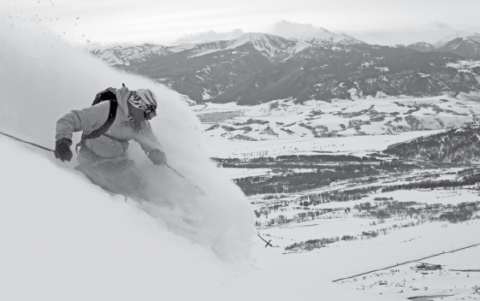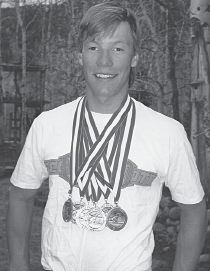
From Jackson Hole to Alaska, the former Olympic downhill champ now makes a living as a mountain and river guide. By Edith Thys Morgan
Pictured above: Moe leads skiers through the Jackson Hole backcountry as a guide. Courtesy of Jackson Hole Mountain Resort.
At 8 a.m. on any given powder day in Jackson Hole, Wyoming, up to a dozen backcountry guides gather for their morning briefing to go over snow, weather and avalanche conditions. From there, they meet their clients on the deck of Nick Wilson’s Cowboy Café and hop on the early tram for a day of adventure on 4,000 vertical feet of skier heaven.
Among the guides is one especially boyish, perpetually grinning 44-year-old who looks more like a puppy straining at his leash than one of America’s most successful and steel-nerved downhill ski racers. If you want to feel what it’s like to play hard—to play like it’s your job, in fact—then let 1994 Olympic downhill champion Tommy Moe be your guide.
Known as “Moe Vibe” among his former teammates, Moe still exudes his famously mellow demeanor, though it masks a heavy metal heartbeat—the edgy tune that hums within every World Cup downhill racer, the riff that kicks in when making split-second decisions at 80 mph. It surely sparked when, heading into the 1994 Lillehammer Games, Moe was featured in Sports Illustrated as a poster child for the beleaguered U.S. Ski Team. SI referred to the team as “Uncle Sam’s lead-footed snowplow brigade,” and described Moe, participating in his second Olympics, as “no soaring success.”
Indeed, Moe’s flight to the top was not direct. The Montana native’s early and spectacular promise was accompanied by youthful exuberance and experimentation that got him kicked out of two ski programs. His father collared him to work construction in chilly Dutch Harbor, Alaska, a stint that firmed up the younger Moe’s resolve to focus his efforts on skiing.
After settling in at Glacier Creek Academy in Alyeska, Alaska, Moe glided through the youth ranks, capturing Junior Olympics titles. In 1989, he also triumphed at the Junior World Championships and U.S. Nationals. That same year, the late coach Dan Bean captured the magnitude of Moe’s potential at a U.S. Ski Team coaches meeting, when he asserted: “If we screw up Tommy Moe, we should all be shot.”
 And yet, by the early 1990s, Moe’s career had stalled. He had speed and looseness, but was missing discipline. With his big-mountain pedigree and laidback attitude, Moe might have been lured into the extreme skiing scene. But instead he chose the path of persistence, buckling down and focusing on refining his lower speed skills with the U.S. technical coach, Thor Kallerud.
And yet, by the early 1990s, Moe’s career had stalled. He had speed and looseness, but was missing discipline. With his big-mountain pedigree and laidback attitude, Moe might have been lured into the extreme skiing scene. But instead he chose the path of persistence, buckling down and focusing on refining his lower speed skills with the U.S. technical coach, Thor Kallerud.
Picture to the left: Moe wearing his medals from the Sun Valley spring series, sometime in the mid-1980s. He rose quickly through the junior racing ranks. Photo courtesy of Megan Gerety.
Everything—skiing, equipment, experience, coaching and teammates— came together in 1994. Despite SI’s dire assessment, AJ Kitt, Kyle Rasmussen and Moe were quietly becoming a force. On the eve of the Olympic downhill, Moe, who was fourth in the final training run, privately decided to win a medal or go down trying. He focused on skiing the hill’s natural rhythm—that so suited his big mountain style—as perfectly and daringly as possible. “To this day when I watch the race, I was the guy who didn’t have that one mistake,” he says.
Not only did Moe win the most coveted and prestigious prize of the Winter Games (only the second American to do so, after Bill Johnson in 1984), but four days later, on his 24th birthday, he captured Super G silver and became the first American male skier to double up on medals in a single Games. Moe had the last laugh with SI, appearing on the cover with the headline, “Golden Boy.”
Moe admits it was tough to stay motivated after Lillehammer, a challenge further complicated with a season-ending knee injury a year later. He retired at age 28 after the 1998 Nagano Olympics—where he placed 8th in Super G and 12th in downhill—with 12 years on the World Cup circuit and five U.S. National titles.
For better or worse, the trappings of fame did not snare Moe. For a brief time one could get caffeinated with a “Tommy Moecha” in Minnesota’s Mall of America. Within the ski industry, he cashed in on the requisite line of gold-medal endorsement deals, and he raced on Jeep’s King of the Mountain Tour for six years. But Moe, who barely overlapped with Bode Miller in 1998, just missed the catapult to mainstream fame ridden by later U.S. Ski Team stars like Miller, Lindsey Vonn, Ted Ligety and Mikaela Shiffrin. “I could have kept going until 2002 (and the Games in Salt Lake),” he says, “but I had achieved my goals and wanted to move on.”
That included business opportunities that leveraged his passion for outdoor adventure sports like kayaking, fishing and big mountain skiing. Along with partner Mike Overcast, Moe started his entrepreneurial career in 1992 by founding Class V Whitewater, a river guiding business that he parlayed into Chugach Powder Guides in 1997. Soon after, Moe realized he needed a home base in the Lower 48 and signed on as Jackson Hole’s Resort Ambassador in July of 1994, a role that has been a perfect fit for the affable, approachable, leave-your-ego-on-the-tram-dock Moe.
In 2003, the same year he was inducted into the U.S. Ski and Snowboard Hall of Fame, Moe married fellow Alaskan, Olympian and downhill racer Megan Gerety. He and Gerety are “both pretty Type A,” he admits. During the winter, Tommy reports for duty at Jackson Hole and travels to ski events while Megan teaches fifth grade full time. Come springtime, Tommy shifts into gear for his Alaska season, based at the Tordrillo Mountain Lodge, which he co-owns. While Megan runs the show at home, Tommy guides 12 guests per week on skiing, fishing and the “Cast and Carve” and “Kings and Corn” fishing/heli-skiing adventures.
All the travel makes the summer downtime at home—with Megan and their two daughters, Taylor (6) and Taryn (4)—all the more precious. “It’s cool because it’s not all about us anymore,” says Moe. “It’s all about them.” In addition to mountain biking, paddleboarding and waterskiing, the family logs time outdoors camping, hiking and fishing.
Moe relishes mixing work and play in his roles as guide, instructor or coach. “Choppers, trams or gondolas: I love it all,” he says. “Being in the mountains, skiing 100 plus days per year and having the life I enjoy...It’s a dream come true.”
